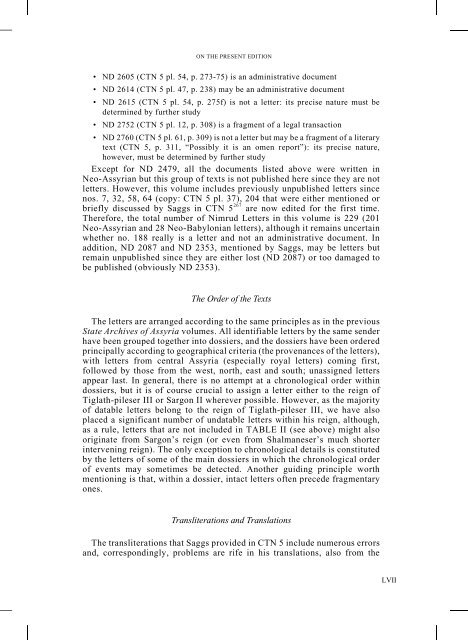Download PDF version of SAA 19 introduction - UCL
Download PDF version of SAA 19 introduction - UCL
Download PDF version of SAA 19 introduction - UCL
Create successful ePaper yourself
Turn your PDF publications into a flip-book with our unique Google optimized e-Paper software.
ON THE PRESENT EDITION<br />
• ND 2605 (CTN 5 pl. 54, p. 273-75) is an administrative document<br />
• ND 2614 (CTN 5 pl. 47, p. 238) may be an administrative document<br />
• ND 2615 (CTN 5 pl. 54, p. 275f) is not a letter: its precise nature must be<br />
determined by further study<br />
• ND 2752 (CTN 5 pl. 12, p. 308) is a fragment <strong>of</strong> a legal transaction<br />
• ND 2760 (CTN 5 pl. 61, p. 309) is not a letter but may be a fragment <strong>of</strong> a literary<br />
text (CTN 5, p. 311, “Possibly it is an omen report”): its precise nature,<br />
however, must be determined by further study<br />
Except for ND 2479, all the documents listed above were written in<br />
Neo-Assyrian but this group <strong>of</strong> texts is not published here since they are not<br />
letters. However, this volume includes previously unpublished letters since<br />
nos. 7, 32, 58, 64 (copy: CTN 5 pl. 37), 204 that were either mentioned or<br />
briefly discussed by Saggs in CTN 5 267<br />
are now edited for the first time.<br />
Therefore, the total number <strong>of</strong> Nimrud Letters in this volume is 229 (201<br />
Neo-Assyrian and 28 Neo-Babylonian letters), although it remains uncertain<br />
whether no. 188 really is a letter and not an administrative document. In<br />
addition, ND 2087 and ND 2353, mentioned by Saggs, may be letters but<br />
remain unpublished since they are either lost (ND 2087) or too damaged to<br />
be published (obviously ND 2353).<br />
The Order <strong>of</strong> the Texts<br />
The letters are arranged according to the same principles as in the previous<br />
State Archives <strong>of</strong> Assyria volumes. All identifiable letters by the same sender<br />
have been grouped together into dossiers, and the dossiers have been ordered<br />
principally according to geographical criteria (the provenances <strong>of</strong> the letters),<br />
with letters from central Assyria (especially royal letters) coming first,<br />
followed by those from the west, north, east and south; unassigned letters<br />
appear last. In general, there is no attempt at a chronological order within<br />
dossiers, but it is <strong>of</strong> course crucial to assign a letter either to the reign <strong>of</strong><br />
Tiglath-pileser III or Sargon II wherever possible. However, as the majority<br />
<strong>of</strong> datable letters belong to the reign <strong>of</strong> Tiglath-pileser III, we have also<br />
placed a significant number <strong>of</strong> undatable letters within his reign, although,<br />
as a rule, letters that are not included in TABLE II (see above) might also<br />
originate from Sargon’s reign (or even from Shalmaneser’s much shorter<br />
intervening reign). The only exception to chronological details is constituted<br />
by the letters <strong>of</strong> some <strong>of</strong> the main dossiers in which the chronological order<br />
<strong>of</strong> events may sometimes be detected. Another guiding principle worth<br />
mentioning is that, within a dossier, intact letters <strong>of</strong>ten precede fragmentary<br />
ones.<br />
Transliterations and Translations<br />
The transliterations that Saggs provided in CTN 5 include numerous errors<br />
and, correspondingly, problems are rife in his translations, also from the<br />
LVII

















